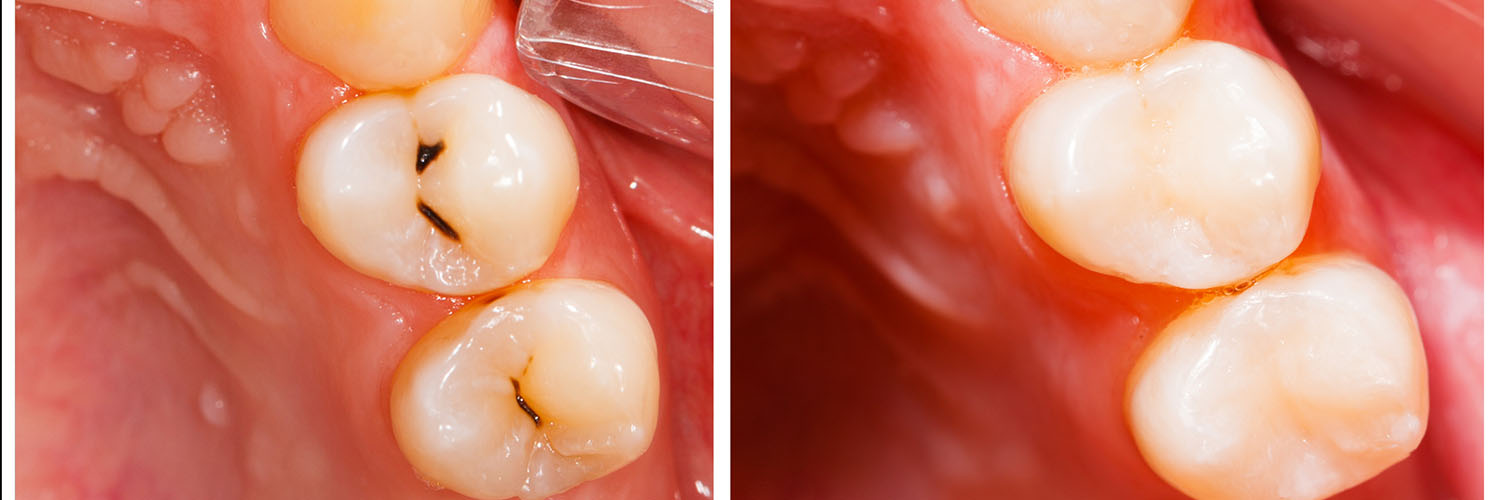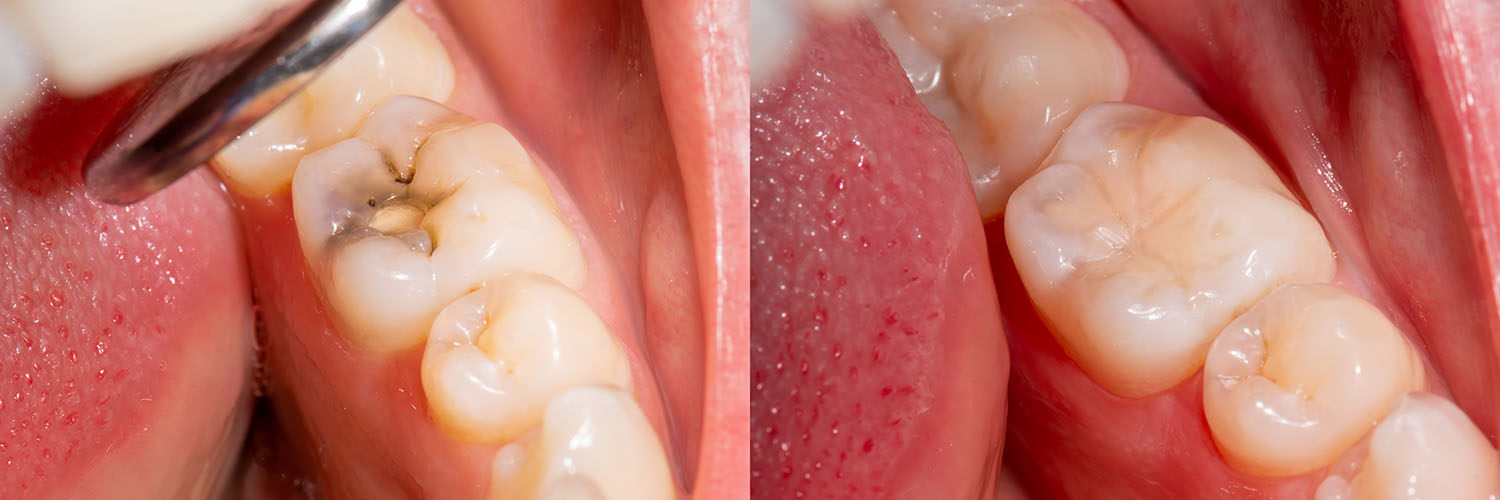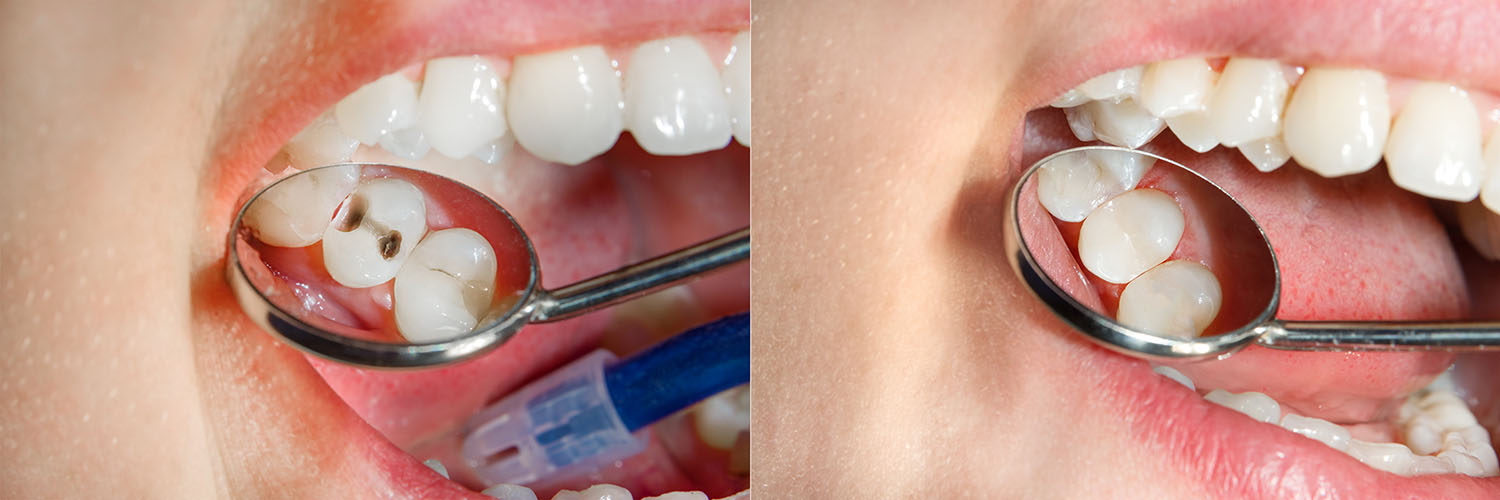Existing Patients
(740) 393-2161
New Patients
(740) 200-4777

A filling is more than a simple patch. When decay or damage weakens a tooth, the goal of restorative treatment is to preserve as much natural structure as possible while restoring strength, function, and appearance. A well-placed filling rebuilds the contours of the tooth so you can chew comfortably, maintain proper bite alignment, and protect the remaining tooth from further breakdown.
Fillings play a central role in everyday restorative dentistry because cavities are common across all ages. Detecting and treating decay early often allows us to use conservative materials that bond to the tooth and minimize the need for more invasive procedures down the road. That preventive mindset is part of how we help patients keep their natural teeth longer.
At Brian Howe DDS, Family Dentistry, our focus is on precise, minimally invasive repairs that look natural and last. We combine careful diagnostic evaluation with proven materials and techniques to restore a tooth’s function while preserving its long-term health and the harmony of your smile.
Human beings have been addressing dental problems for millennia, but the materials and methods have changed dramatically. Early attempts at restoring teeth were creative but limited by available tools and substances. The past two centuries introduced metals like gold and amalgam, which provided durable relief but lacked aesthetic appeal.
Over the last several decades, dental materials science has expanded the options available to clinicians. Tooth-colored composites and ceramics offer reliable strength without sacrificing appearance. These advances let us tailor restorations to each patient’s functional needs and cosmetic goals while avoiding metals when a more natural result is desired.
Understanding how materials have evolved helps explain why we recommend specific options for different situations. Durability, tooth preservation, aesthetics, and the location of the cavity are all factors we weigh when advising on the best restorative approach.

Not every filling is the same. Modern dentistry offers a range of restorative materials, each with strengths that suit particular circumstances. The decision about which material to use depends on factors such as the size and position of the cavity, the tooth’s role in chewing, aesthetic priorities, and long-term durability.
We’ll discuss the trade-offs for each option during your visit so you can make an informed choice. Our team prioritizes solutions that preserve tooth structure, restore proper function, and produce a natural-looking result that complements your smile.
Composite fillings are made from a blend of resin and glass or ceramic particles. They are matched to your tooth’s natural shade, and the material bonds directly to the remaining tooth structure. This adhesive quality allows for more conservative preparations and helps reinforce weakened teeth.
Composites are versatile: they can be used to repair small to moderate cavities, reshape slightly worn or chipped teeth, and improve minor cosmetic flaws. While very durable, composites can show wear over many years and may require maintenance or replacement depending on chewing forces and oral habits.
Amalgam has a long history as a reliable material for back teeth where chewing forces are highest. These silver-colored restorations are known for their strength and resistance to wear, making them a practical choice in situations where durability is the primary concern.
While amalgam is less commonly used for visible front teeth because of its appearance, it remains a useful option for certain posterior restorations when longevity under heavy bite pressure is essential.
Glass ionomers bond chemically to tooth structure and release fluoride over time, offering a protective effect that can be helpful near the gumline or in pediatric dentistry. These materials are often used for temporary restorations or in areas with light chewing pressure.
Because they are generally less wear-resistant than composites or ceramics, glass ionomers are best suited for small fillings, primary teeth, or situations where the fluoride release and gentle bonding properties provide an advantage.
Ceramic restorations—fabricated from durable dental porcelain—are an excellent tooth-colored solution for larger defects. Inlays and onlays are made outside the mouth and then bonded into place, which allows for precise shaping and a highly esthetic finish that resists staining.
These indirect restorations are often chosen when a cavity is too large for a direct filling but the tooth can still be preserved without a full crown. They combine longevity with a natural appearance and are particularly well-suited to patients who prioritize cosmetic outcomes.
Gold offers an exceptional combination of strength, longevity, and biocompatibility. Although less commonly selected today because of its color and cost, gold restorations perform reliably for decades in high-stress chewing areas and are gentle on opposing teeth.
Where appropriate, gold remains a premium restorative choice for patients who value durability and precision fit over aesthetic considerations.

Effective cavity treatment begins with clear diagnosis. We use a combination of visual examination, digital radiography, and intraoral imaging to accurately locate decay and evaluate how much healthy tooth structure remains. This information guides our recommendations and treatment plan.
When a filling is indicated, the procedure typically takes place under local anesthesia so you remain comfortable throughout. We use precise instruments—ranging from traditional rotary tools to air abrasion or laser systems when appropriate—to remove decay while conserving healthy tooth material.
After preparing the cavity, we place the selected restorative material using techniques that maximize adhesion and minimize microleakage. Our team carefully sculpts the filling to restore natural contours and then checks your bite, making fine adjustments to ensure comfort and proper function.
For patients who experience dental anxiety, we offer options to enhance comfort, including discussions about sedation dentistry. Our priority is to create a calm, supportive experience for every patient while delivering reliable clinical results.
Immediate aftercare focuses on comfort and protection while your tissues recover and any local anesthesia wears off. Most patients return to normal eating and oral hygiene within a day, though a newly placed filling may feel slightly different until you adapt to the restored tooth surface.
Short-term sensitivity is common. It’s normal for a treated tooth to be mildly sensitive to hot or cold foods for a few days. This response typically subsides as the tooth heals and the restoration settles. If sensitivity persists or increases, contact us so we can evaluate the restoration and the tooth’s vitality.
Protect numb tissues
After your appointment, your lips, cheek, or tongue may be numb for one to two hours. Avoid chewing or eating until sensation returns to prevent accidental biting.
Adjustment period
It can take a short time to get used to the way a restored tooth feels. If your bite feels high or uneven after the numbness wears off, come in for a quick adjustment so chewing feels natural and comfortable.
Watch for unusual symptoms
Expect minor tenderness initially, but persistent pain, swelling, or severe sensitivity should be evaluated. These signs can indicate that further treatment is needed to protect the tooth’s long-term health.
Look after your restoration
Good oral hygiene and routine dental visits are the best ways to extend the life of any filling. Avoid chewing very hard objects and let us know if you notice wear, discoloration, or a change in how the filling feels.
We aim to make your restoration durable and comfortable. If you have questions about care, sensitivity, or expectations after a filling, please contact our office for guidance.

Dental fillings are a cornerstone of conservative dentistry: they halt decay, restore function, and help protect the long-term integrity of your teeth. Choosing the right material and following appropriate aftercare are key to a successful outcome.
If you’d like to learn more about how a filling could help preserve your smile, or to discuss which material might be best for a specific tooth, reach out to our team. The office of Brian Howe DDS, Family Dentistry is happy to answer questions and explain options so you can make confident decisions about your care.
Contact us to request more information or to schedule an evaluation — we’re here to help you maintain a healthy, comfortable, and attractive smile.
A dental filling is a restorative material used to repair a tooth after decay or damage has been removed. The goal is to restore the tooth's shape and function while preserving as much healthy structure as possible. By sealing the cavity, a filling prevents bacteria from re-entering and stops further breakdown of the tooth.
Modern fillings are placed using adhesive techniques that bond the material to the natural tooth, which can strengthen and stabilize the remaining tooth. This conservative approach often avoids the need for more extensive treatment such as crowns or extractions when decay is caught early. Routine examinations and prompt treatment are key to keeping restorations simple and effective.
Contemporary dental restorations include tooth-colored composite resins, glass ionomer cements, ceramic inlays and onlays, amalgam, and gold when appropriate. Composites and ceramics offer superior aesthetics and bond to tooth structure, while glass ionomers release fluoride and can be helpful in specific clinical situations. Amalgam and gold are known for their durability in high-stress chewing areas and may still be recommended for posterior teeth.
Each material has trade-offs related to strength, longevity, wear resistance, and appearance, so the choice depends on the tooth's location, size of the defect, and the patient's priorities. Your dentist will explain the benefits and limitations of each option to help you select the most appropriate solution. When long-term aesthetics are important, ceramic or well-matched composites are often preferred.
The decision is based on a clinical evaluation that considers the size and position of the cavity, how the tooth functions in your bite, and the amount of remaining healthy structure. Radiographs and intraoral imaging help determine the extent of decay and whether a direct filling or an indirect restoration like an onlay is needed. We also consider aesthetic goals and any history of bruxism or heavy chewing forces when recommending a material.
The patient’s oral health and risk factors—such as ongoing decay, sensitivity, or gumline involvement—also influence the selection. When appropriate, the restorative plan aims to conserve tooth structure while delivering reliable function and appearance. A clear discussion of options ensures you understand why a particular material is recommended for your situation.
Treatment begins with a thorough exam and local anesthesia to keep you comfortable during the procedure. The dentist removes decayed tissue using precise instruments, which may include rotary tools, air abrasion, or laser systems depending on the case. Careful removal of decay and preservation of healthy tooth are the priorities at every step.
Once the cavity is prepared, the chosen material is placed and shaped to restore natural contours and proper bite alignment. Composites are cured with a light to harden the material, while indirect restorations are fabricated in a lab or milled and then bonded in a subsequent appointment. The dentist will check your bite and make any final adjustments so the restoration feels comfortable during chewing.
Mild short-term sensitivity to hot, cold, or pressure is common after a filling and usually subsides within a few days to weeks as the tooth settles. This response occurs as the nerve adjusts to the change in tooth structure and from the effects of local anesthesia wearing off. Over-the-counter analgesics and avoiding very hot or cold foods can help during the initial adjustment period.
If sensitivity increases, persists beyond a few weeks, or is accompanied by severe pain, swelling, or signs of infection, contact the office for evaluation. Persistent symptoms can indicate an improper bite, microleakage, or deeper problems that may require additional treatment like a replacement restoration or root canal therapy. Prompt assessment helps protect the tooth and prevent more invasive procedures.
The longevity of a filling depends on the material used, how large the restoration is, how much chewing force the tooth endures, and your oral hygiene habits. Tooth-colored composites and glass ionomers may need maintenance sooner than ceramics or gold in some situations, while amalgam and gold are traditionally long-lasting in posterior teeth. Regular dental checkups allow your dentist to monitor restorations and address wear before it becomes a larger problem.
You can help extend the life of a filling by practicing good oral hygiene, avoiding chewing very hard objects, wearing a night guard if you grind your teeth, and attending routine professional cleanings. Addressing decay early and repairing small defects can also prevent the need for larger restorations. If you notice changes such as roughness, discoloration, or a different bite sensation, schedule an exam so the restoration can be evaluated.
If decay or damage removes a significant portion of the tooth, or if the tooth has a fracture that threatens structural integrity, a full-coverage crown or a ceramic onlay may be a better long-term solution. Onlays and crowns provide additional strength and protection when a direct filling would require removing excessive healthy tooth to retain the restoration. The choice depends on how much tooth remains and the functional demands placed on that tooth.
Your dentist will discuss alternatives when a filling is unlikely to provide durable support, explaining the benefits of an onlay or crown for preserving the tooth and preventing recurrent problems. Conservative onlays often allow more natural tooth preservation than crowns while offering enhanced longevity compared with a large direct filling. Selecting the right restoration aims to achieve predictable function and minimize the need for repeat interventions.
Advances in composite resin technology have significantly improved their strength and wear resistance, making them a reliable option for many restorations. Composites bond to tooth structure and can actually reinforce a weakened tooth, which is a clinical advantage over non-adhesive materials. However, metal restorations like gold and amalgam have a long track record of durability in very high-stress posterior areas.
The decision often balances aesthetic preferences, the size of the cavity, and functional demands; for many visible and moderate-sized restorations, composites provide an excellent blend of appearance and performance. In cases of extremely heavy chewing forces or very large restorations, indirect ceramic or metal options may offer superior longevity. Your dentist will recommend the material that best meets your clinical needs and cosmetic goals.
Immediately after treatment, avoid chewing on the restored tooth until numbness wears off to prevent soft-tissue injury, and follow any specific instructions your dentist provides about eating or oral hygiene. Routine brushing and flossing should resume once you are comfortable, taking care around the treated area at first. If your bite feels uneven after the filling, contact the office so the dentist can make quick adjustments.
Long-term care includes maintaining excellent oral hygiene, attending regular dental checkups, and protecting teeth from excessive forces by addressing habits like nail biting or using a mouthguard for sports. Professional exams and radiographs allow early detection of recurrent decay around fillings or wear that may necessitate repair. Good preventive care is the most effective way to maximize the lifespan of any restoration.
Common indicators include new or worsening sensitivity, persistent pain, a visible crack or chip in the filling, rough or uneven edges, and a feeling that the bite has changed. Discoloration around the margins or a dark line near the restoration can also signal breakdown or leakage. Sometimes a filling can fall out entirely, which requires prompt evaluation to protect the exposed tooth.
If you experience any of these signs, contact the office of Brian Howe DDS, Family Dentistry for an assessment so the tooth can be evaluated and appropriate restorative options discussed. Timely attention helps prevent progression of decay and preserves as much natural tooth as possible. Routine follow-up visits are a practical way to catch developing problems early and maintain overall oral health.
Our friendly and knowledgeable team is always ready to assist you. You can reach us by phone at (740) 393-2161 or by using the convenient contact form below. If you submit the form, a member of our staff will respond within 24–48 hours.
Please do not use this form for emergencies or for appointment-related matters.
